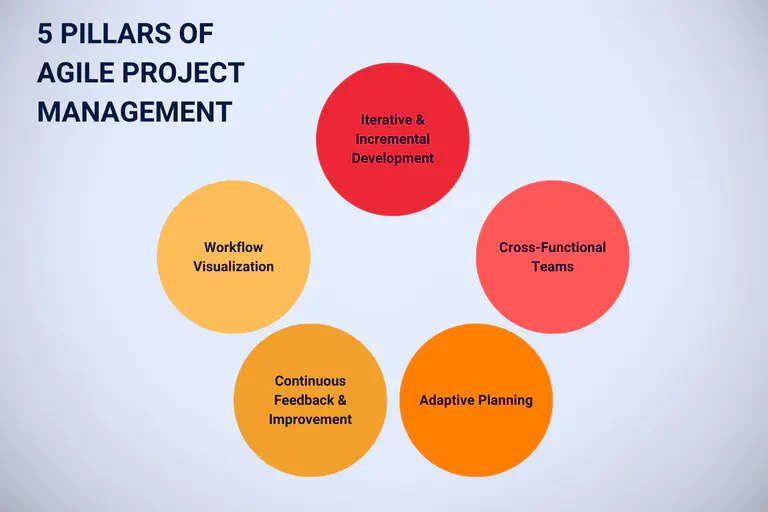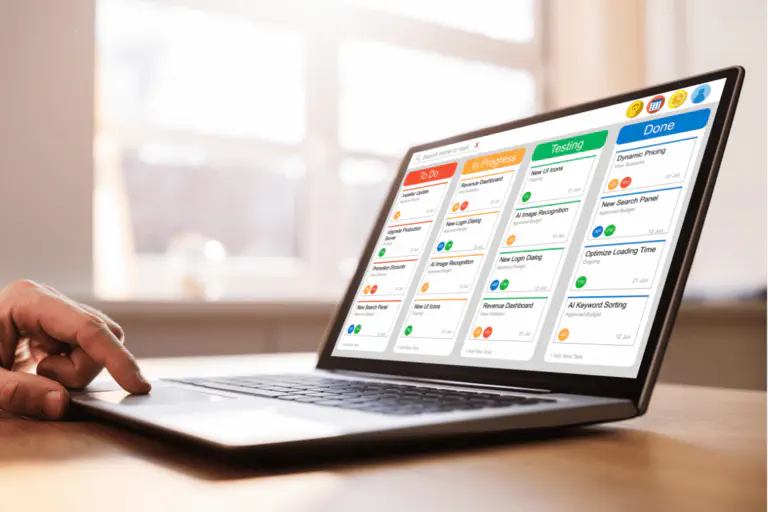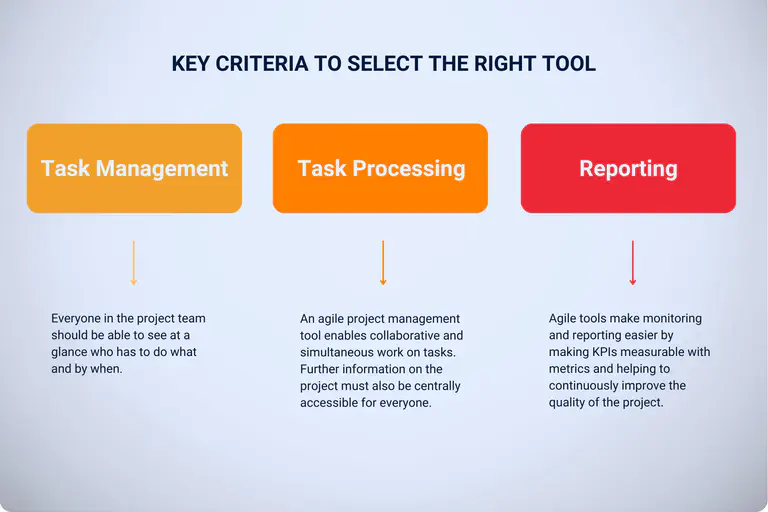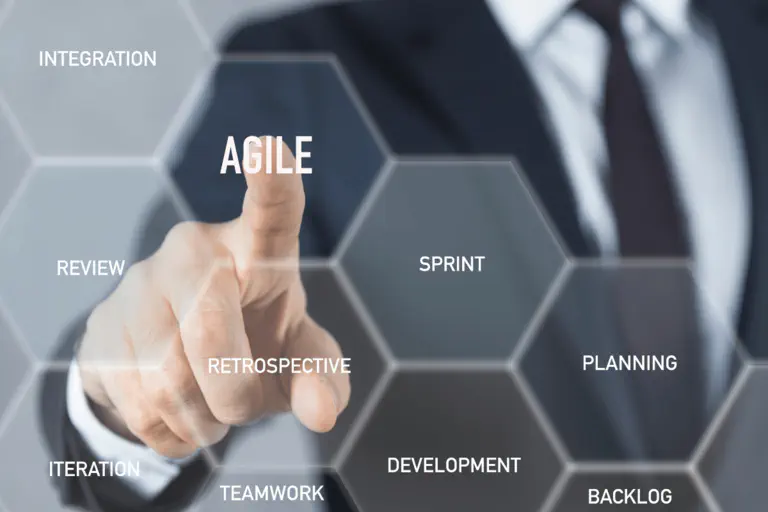Why agile project management? #
Teams should be able to react flexibly and quickly to changes in a project in order to achieve the best possible result for the customer given the circumstances. Agile project management promotes precisely this adaptability and ensures that feedback and customer wishes are incorporated into development at an early stage.
Agile methods allow you to develop, test and present initial results quickly. In this way, a product is created step by step that is precisely tailored to the needs of your customer.
Various agile tools support you in successfully implementing agile project management in your company. Read more about methods such as Scrum or Kanban and find out how agile project management tools can help your team to make projects more flexible and efficient.
How does agile project management work? #
Agile project management divides complex processes into manageable sections and assigns specific roles, such as Product Owner and Scrum Master. This allows your team to work together in a structured and flexible way. Instead of pursuing a rigid end goal, agile project management focuses on maximizing customer value and responding quickly to changing requirements.
The project is divided into sprints, each representing short, clear work phases in which you pursue defined tasks and goals. Plans are continuously put to the test and can be adapted so quickly that your team can respond flexibly to new developments. Regular meetings enable effective communication and interim results are presented on an ongoing basis to gather feedback and ensure that the project is meeting needs.

For which projects is agile project management suitable? #
Agile project management is particularly suitable for projects that are characterized by a high degree of dynamism and rapid changeability. This includes not only software and product development, but also marketing campaigns, research projects or innovation projects where regular feedback and rapid adjustments are crucial.
Agile tools and methods are ideal for use when requirements are not yet clearly defined or are likely to change over the course of the project. Agile project management also shows its strengths in projects that require close collaboration with your customers or various stakeholders. Customer-oriented and innovative solutions can be developed through iterative and flexible working methods.
Are there methods for agile project management that you should know? #
There are a number of methods in agile project management that you can adapt flexibly to the requirements of different projects. The best known are Scrum and Kanban, which each offer specific approaches to structuring and optimizing work processes. Let’s take a closer look at Scrum and Kanban to see how these two approaches differ.
Scrum - the classic for agile project management #
When you use Scrum, you clearly define both the roles of the project participants and the planned results and events. Partial results are developed in short sprints - in product development, for example, this could be a new product version or a specific function. These interim results are presented to the customer in order to obtain feedback and make adjustments at an early stage.
Agile working with Kanban #
You may already be familiar with the Kanban board as an important agile project management tool. Here, tasks are recorded in digital cards on a board, managed and organized in different columns - such as “To do”, “In progress” and “Done”. This makes the progress of each task visually traceable, the team can identify bottlenecks at an early stage and manage the workflow efficiently. This structure helps to continuously improve the current status and to steadily advance projects through many small, quickly implementable steps.

Why are the tools so important for agile project management? #
The right tool helps you take your agile project management from theory to practice. Resources are distributed efficiently, communication within the team is simplified and clear task management is introduced. The right tools also enable greater transparency: Team members can see the progress of all tasks and project managers can identify bottlenecks or delays at an early stage.
Agile project management tools also provide you with valuable insights into various key performance indicators (KPIs) that show how successful the project has been so far and where adjustments may be necessary. This keeps everyone involved informed at all times and allows them to react flexibly to changes in order to ensure the success of the project.
Criteria for selecting the right tool #
To find tools for your agile project management, you should get an overview of the software and apps available on the market. Then test several programs and determine whether they meet your requirements.
How much benefit do you get for the price and can other agile project management tools do more? Can your employees handle the user interface and are they satisfied? What about the functions? Agile work tools should always cover the following three areas:
- Task management: Everyone should be able to see at a glance who has to do what by when.
- Team collaboration: An agile project management tool enables tasks to be processed jointly and simultaneously. Further information about the project must also be centrally accessible for everyone.
- Reporting: Stakeholders may expect a progress report after each sprint. Agile tools make this task easier for you by making KPIs measurable with metrics and helping to continuously improve the quality of the project.

Which tools are available for agile project management? #
Before you invest in tools for your agile project management, it is worth making a comparison. In the following 10 programs and cloud solutions , we take a look at the range of functions, user-friendliness, collaboration options, hosting, data protection and costs. This reveals interesting differences and lesser-known tools that compete with the top dogs and score points as a Jira alternative or Trello alternative, for example.
Asana #
Asana is one of the most popular tools for task and project management and boasts a user-friendly interface and intuitive operation. You can assign different categories with colors for notes. You can display your data in a Gantt chart as well as in lists or a Kanban board. Team collaboration is supported by the “Teams”, “Inbox” and “Discussions” areas. Even though reporting in Asana is limited to simple statistics, the tool impresses with its GDPR compliance thanks to server locations in Europe. Some details, such as the filter functions for tasks that are available in other agile project management tools , are missing in Asana. However, the simplified presentation allows project participants to concentrate on the essentials. The San Francisco-based company offers a pure cloud solution that you can use easily and without additional infrastructure, although this removes the option of self-hosting. Getting started is free, while paid subscriptions start at 10.99 euros per user/month.
monday.com #
monday.com is an alternative that scores with its customizable workflows and different project views. These give every team the freedom to tailor the agile project management tool to their needs. With powerful automation and real-time collaboration, it makes it easier to organize complex work processes. While it is relatively complicated to use and requires some initial training, monday.com offers comprehensive dashboards and reporting features for reporting. The Israeli company has designed its software as a completely cloud-based tool and therefore offers no option for local operation. In terms of data protection, you cannot host the software yourself, but you can at least operate it in compliance with the GDPR, as servers in the EU are available. The paid subscriptions start at 9 euros per user/month, which makes monday.com a scalable solution that, like Asana, quickly runs into money.
Jira #
Jira, a product of the Australian company Atlassian, is known for its extensive agile project management functions, which are aimed in particular at agile methods such as Scrum, Kanban and Extreme Programming. Flexibly customizable workflows make it possible to manage complex projects in a structured way. However, due to its diverse options and integrations - especially with other Atlassian products - Jira requires a lot of prior knowledge and longer familiarization. The solution was originally designed for development teams and even they sometimes struggle to keep track of the complex functions. With comprehensive reporting and analysis capabilities, Jira Software is particularly suitable for teams that need detailed insights and statistics. Depending on your needs, you can either use Jira as a cloud version via AWS or host it on your own hardware. Server locations in Dublin and Frankfurt am Main promise GDPR compliance. A free version is available for small teams with up to 10 users, while paid subscriptions start at €7.90 per user/month. As it is not easy to export projects from Jira to other agile project management tools, you should think carefully about using it beforehand. Atlassian naturally wants to prevent you from switching to a Jira alternative at short notice.
Trello #
As an agile project management and collaboration tool, Trello is Atlassian’s in-house Jira alternative. It is based on Kanban boards and is used to organize projects and tasks with cards for teams and individuals. Although the reporting functions are sparse compared to other tools, Trello can be individually expanded using so-called power-ups. With comments, mentions and easy team collaboration, Trello enables efficient collaboration without being cluttered. Trello is an intuitive tool that impresses with its simple design. The user interface is simple and clear, which makes it easy to manage tasks and projects. In comparison, however, Trello offers a rather small range of functions, which makes almost all agile tools a fully-fledged Trello alternative. Trello runs exclusively via the cloud and is not designed for on-premises installations. Atlassian itself claims to respect the GDPR, although Trello’s headquarters and servers are located in the USA. The tool is available in a free basic version and the paid subscriptions start at 5 US dollars per user/month.
ClickUp #
Another product from the United States is ClickUp. This software impresses with its comprehensive functionality, which ranges from versatile agile project management features to customizable views and workflows to integrated documentation and whiteboards. This variety allows teams to customize the tool to their exact needs, although this does require a some training period. Extensive communication options and team tools facilitate coordination. With reporting features and dashboards, ClickUp provides detailed insights into the team’s progress and performance. The tool for agile project management is only available as a cloud solution and cannot be installed locally. Compliance with the GDPR and the option to select European servers from AWS for data storage should ensure secure data protection. The basic version is free of charge, while paid subscriptions start at 7 US dollars per user/month.

MeisterTask #
MeisterTask relies on a clear, user-friendly interface and an attractive design that makes managing tasks and projects a breeze. As a Trello alternative, the tool is based on the Kanban approach and enables time tracking and automation in addition to task management. The Kanban boards allow tasks to be moved easily and according to the current processing status. Simple collaboration with comments and mentions makes MeisterTask easy to use and promotes transparent teamwork. While reporting remains simple, it is sufficient for many teams. The software from the German company MeisterLabs is only available in the cloud and therefore offers a simple, scalable solution for teams, but not self-hosting. Data protection is still a top priority: MeisterTask is GDPR-compliant and the cloud servers are located in Germany. A basic version is available free of charge, while paid subscriptions start at 13.50 euros per user/month.
awork #
Kanban boards, timelines, lists - awork is ideal for agile project management. The ClickUp alternative relies on a clear user interface with which projects can be individually configured, planned and executed. In addition, tasks can be easily moved using drag-and-drop and a live function ensures automatic updating of the browser window. This means that every change is displayed transparently and all team members always have the same, up-to-date information. The tool offers numerous analysis options for reporting, which can be summarized in clear dashboards with just a few clicks. Thanks to flexible team collaboration through real-time comments, mentions and file sharing, communication within the team runs smoothly. The company is based in Hamburg, awork is GDPR-compliant and is hosted in Germany, which ensures a high level of data security. The agile project management tool is only available as Software-as-a-Service and cannot be hosted on-premises on its own servers. Thanks to its open Rest API, the tool can be connected to numerous apps. The costs start at 8 euros per user/month, which makes awork a cheaper German MeisterTask alternative.
Wrike #
Wrike, on the other hand, has its origins in the USA and is an agile project management tool that can be both a ClickUp alternative and an awork alternative. Whether fully linked calendars, personalized Kanban boards or flexibly prioritizable tasks - it offers a lot of features. As a project management tool, Wrike also focuses on real-time collaboration within the team, cross-project reporting and up-to-the-minute news feeds. Reports and statistics are one of Wrike’s strengths: Interactive dashboards can be used to gain detailed data and project insights. Wrike enables full API usage, but is based in the cloud and is only offered as a SaaS option. Self-hosting is therefore not possible, but according to the company, data protection is guaranteed by compliance with the GDPR and European server locations. In addition to a free basic version, Wrike offers four paid subscriptions starting at 10 US dollars per user/month, making the tool suitable for growing teams.
Redmine #
Redmine is an open source software for agile project management that is free and extremely compatible with other solutions. As an alternative to Jira, Redmine also includes detailed ticket and bug management as well as Gantt charts for project planning. However, Redmine is only suitable for tech-savvy teams, as installation and configuration require in-depth IT knowledge. Although the software can be extended with plugins and themes, it is less user-friendly than other tools, as it is more difficult to familiarize yourself with Redmine and the antiquated user interface is visually unappealing. The reporting functions are versatile and can also be expanded using plugins. As a Jira alternative, Redmine basically allows team collaboration, but without advanced functions for conflict avoidance in the context of real-time synchronization. As Redmine can be self-hosted, data sovereignty remains completely with the user, which enables the highest security standards.
SeaTable #
SeaTable is an agile project management tool that flexibly adapts to the requirements of your company or project. The software boasts an impressive range of features that go far beyond agile project management and also cover other business processes. Thanks to numerous display formats such as Kanban boards, Gantt charts and lists, you can plan and organize all your tasks comprehensively. The intuitive user interface and flexible customization options make the tool understandable and easy to use even for inexperienced users.
If you are looking for agile project management software that supports smooth team collaboration through real-time synchronization, comments and shared file management, SeaTable is the right tool for you. This tool keeps all your team members up to date and the project status transparent. The analysis options include customizable dashboards and statistics that allow you to review project progress at regular intervals and make informed decisions.
SeaTable offers you maximum flexibility in your choice of hosting: you have the option of hosting the software yourself and installing SeaTable On-Premises on your own servers, or you can use the convenient and scalable cloud version, while maintaining the highest security standards. SeaTable is a German company that stores all data GDPR-compliant on German servers. In the free basic version you have numerous basic functions at your disposal. For more advanced requirements, SeaTable offers attractively priced subscriptions from 7 euros per user/month.
In our library you will find project management templates , which you can use immediately in the free basic version.
Better results through agile project management #
Agile project management ensures the greatest possible added value for you and your customers - regardless of whether they are external clients or internal stakeholders. Agile tools ensure that projects can react flexibly and efficiently to changes, while at the same time the quality and speed of project work remains high. As agile project management is now firmly established in many companies, a wide range of powerful tools are available to support your way of working and can be adapted to individual project requirements.
The tools presented may seem quite similar at first glance, but they differ greatly in terms of which functions are free, whether they offer self-hosting or pure cloud solutions, how and where your data is stored and how much training time users need. Trello and SeaTable, for example, are the cheapest tools, although Trello is only available on US cloud servers and offers a significantly smaller range of functions. With comparable Kanban functions, almost all other tools offer a fully-fledged Trello alternative. On the other hand, SeaTable and Trello with their simple design are much more intuitive than monday, Jira or Redmine, which can initially overwhelm users with their complexity.
Compare thoroughly and choose the right tool for your needs. If you are looking for agile project management software that promises maximum flexibility and cost efficiency, SeaTable is probably the best choice. Try it out and register for free with your e-mail address today.
Register for our newsletter and stay up to date on all things project management!
